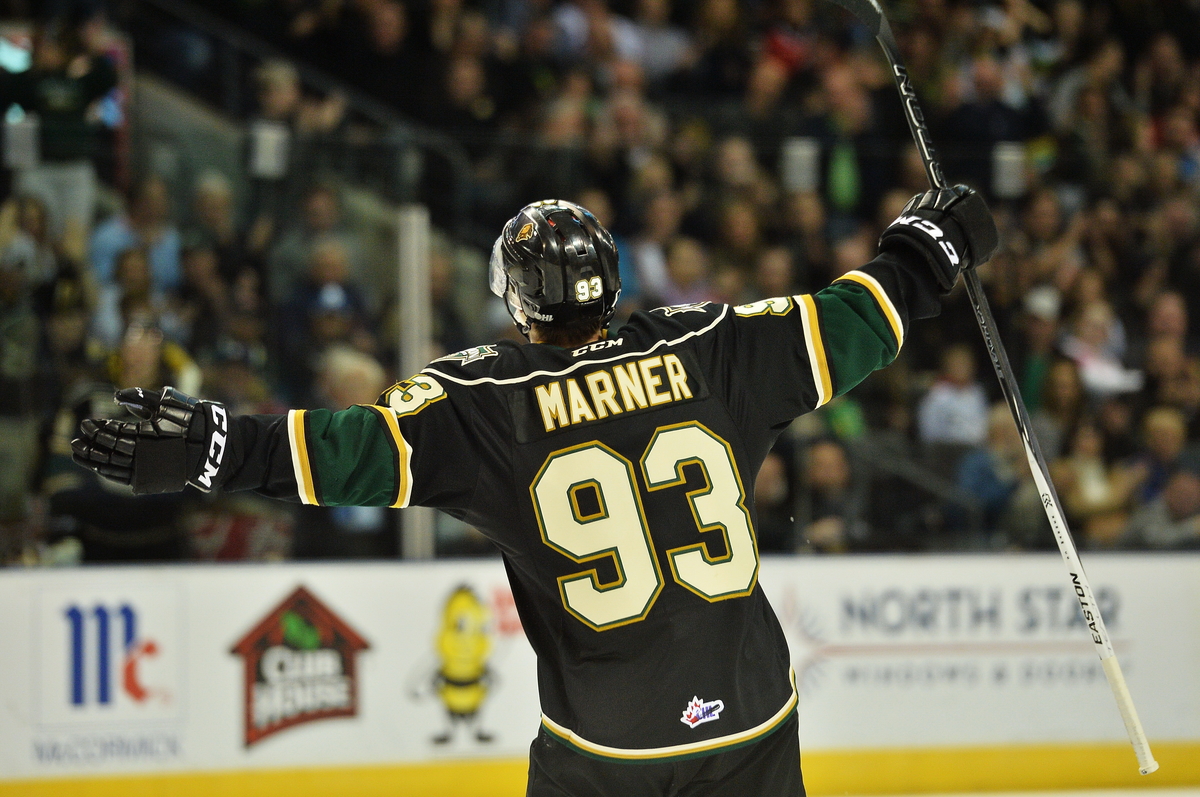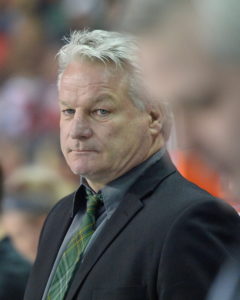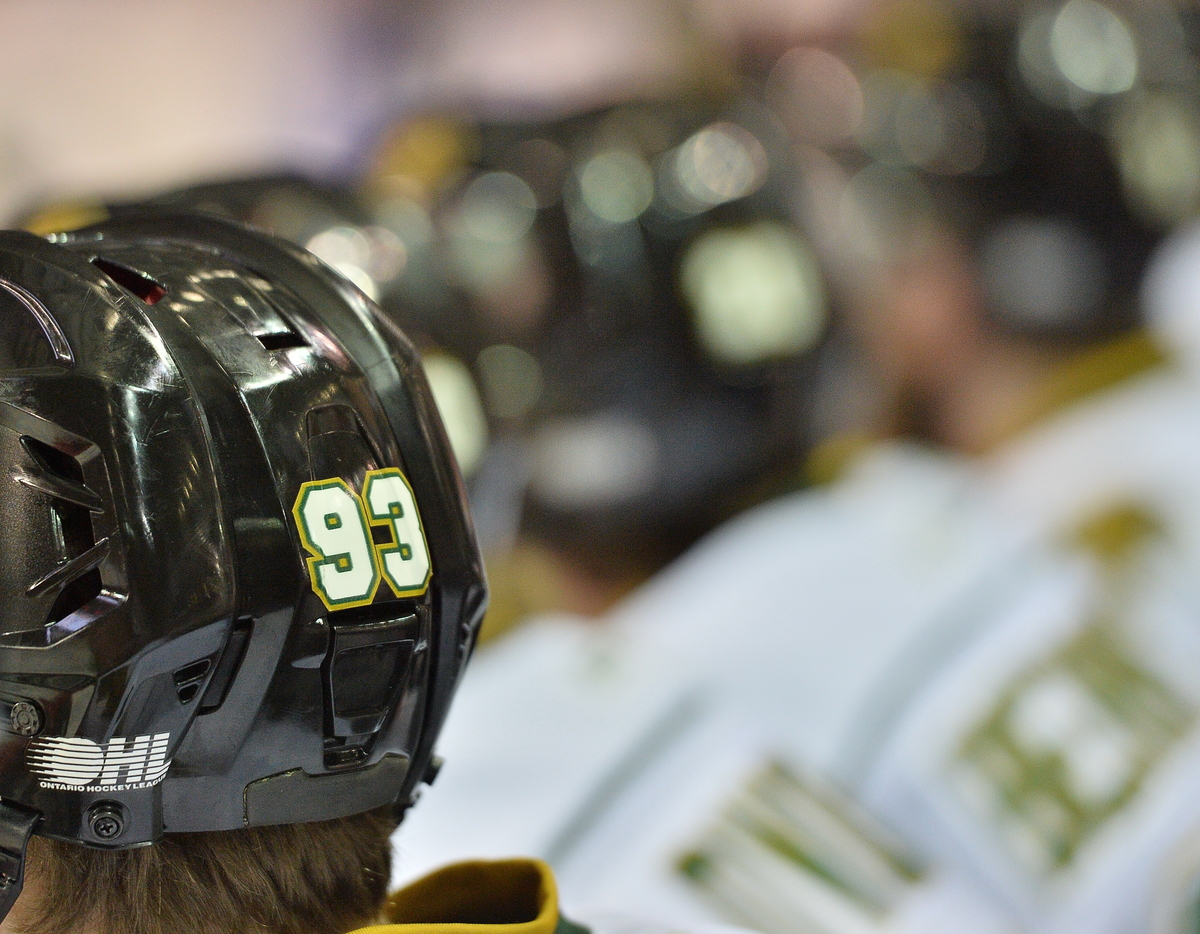Below, long-time MLHS member, Knights2Leafs, reflects on the stunning playoff run by the 2016 OHL champion London Knights, with notes from editor Alec Brownscombe.
As a long-time London Knights seasons ticket holder, I’ve had the great fortune of watching a lot of fantastic hockey during the Dale and Mark Hunter years.
There have been some great teams and some very good teams in the Hunter era. Instead of breaking down each of the three prior London teams that earned their way to the Memorial Cup (2005, 2012, 2013), what I thought I would do is compare and contrast this year’s team to the less successful (but not, I’ll argue, necessarily worse on paper) group that hosted the 2014 Memorial Cup in Mitch Marner’s rookie season.
The 2014 Knights vs. The 2016 Knights
Dale Hunter has always had his teams — great, good or just average, but never bad — play pro-style hockey. All of Hunter’s players are taught to play a 200-foot game. Dale’s teams tend to be fast and skilled with a little size mixed in, and he is famous for running four lines and having them play full-out all night long. That was the 2005 Memorial Cup team to a T, and likewise for the two teams that earned a berth into the Memorial Cup in 2012 and 2013. The 2014 team was built and played in the same mould, but for whatever reason never achieved the same success.
The 2014 Knights had a goaltending tandem (Anthony Stolarz: .926SV% over 35GP; Jake Patterson: .897SV% over 39GP, after a .913 season the year before) that should have provided similar goaltending to the current team’s (Tyler Parsons: .921 over 49GP; Brendan Burke: .896 over 19 GP). It had a superior defensive corps, featuring the likes of Nikita Zadarov and Dakota Mermis. Their defense group was bigger, more physical, and more mature than the 2016 model; probably better defensively, and quantifiably more productive offensively. The 2013-14 team’s top six blueliners (by point scoring) produced 147 points over the course of the season, compared to the 137 in 2015-16.
While the forward group did not have had a line to match Mitch Marner, Christian Dvorak and Matthew Tkachuk, they had more depth from forwards four through 14, and their top three were no slouches in Max Domi, Bo Horvat and Chris Tierney. Total production among forwards to play a game for the Knights, excluding the top three, amounted to 162 goals and 357 points in 2015-16, compared to 169 goals and 431 points in 2013-14.
Like the 2016 team, they played in probably the toughest division in the entire OHL, finishing behind an incredibly strong Guelph team and a very good Erie team. London still had 103 points, the third most in the OHL by a long shot, but they lost out in the second round of the playoffs to Guelph in five games. They were fairly beat up, but given the depth of their lineup, there was some hope that they could still compete for the Memorial Cup. They went on to lose all three games in the tournament.
Fast forward to 2016. This Knights team had some shaky goaltending to start the year. Their penalty kill was a disaster early on, running around a 50% success rate, and even their PP wasn’t earth-shattering to start the season. The defense corps isn’t particularly big, other than Chris Martenet, who handles the puck like a grenade, and they were extremely young overall. At forward, the Knights brought in some nice pieces like Matthew Tkachuk, Max Jones, JJ Piccinich, Kole Sherwood, and Sam Miletic, but generally speaking they were young, inexperienced, and lacked a little depth.
The 2014 team had strength down the middle with Horvat, Tierney, Ryan Rupert and Brett Welychka at centre, all of whom had Memorial Cup experience. Contrast that with the 2016 team — Hunter started the season off with Dvorak as his 1C and Marner as his 2C without much behind those two (Owen Macdonald and Cliff Pu).
With that as the background, how did the 2016 team end up tying for first overall in the OHL before wiping out everyone in the playoffs, setting an OHL record (13 consecutive postseason wins) in the process?

The Genius of Hunter
After 14 games, Dale Hunter moved his second-line center, Mitch Marner, from 2C to first-line right wing. Marner posted 16 points in 10 games playing center to start the year — not terrible by any means — but he proceeded to post a ridiculous 16 points in the next five games after the move to wing.
This left Cliff Pu, a 17 year old who had all of 9 points as a 16 year old, as their 2C, and Owen MacDonald — a journeyman at best — as their 3C. It was a gutsy move, to be sure.
Next, to take care of the terrible penalty killing, at forward Hunter started using Marner and Dvorak on a regular basis, as well as Cliff Pu and either Max Jones or Chandler Yakimowicz.

The next move was to take the Leafs’ JJ Piccinich from the top six, where he had played extremely well with Marner on his wing, and move him to the third checking line, where he became a shut down machine.
The last move Hunter made came near trade deadline in the acquisition of Jacob Graves, an overage defenseman with decent size. While he barely qualifies as a top-four defenceman, the move helped stabilize the defense corps, allowing Hunter to use Olli Juolevi and Victor Mete with Martenet as his top four, while mixing in young up-and-coming defenceman to give them some experience.
It would be a misconception to suggest that Hunter currently rolls his four lines nonstop at the opposition as he has done with his teams in the past. He hasn’t, because he doesn’t have the forward depth or the defensive depth. Instead, he began running three lines 90% of the time.
MacDonald centered his shut down line with Piccinich and Yakimowicz, while Aaron Berisha was added to Pu and Jones in what became a very effective second line, both in offering complementary scoring and more importantly in becoming possession beasts.
That leaves us with Marner, Dvorak and Tkachuk, the Knights’ triumvirate of 100-plus point scorers. Hunter started playing the stuffing out of Marner and Dvorak. The pair not only saw more than their fair share of five-on-five time, they played huge minutes on both sides of special teams. While we don’t have time-on-ice figures available from the OHL, it wouldn’t surprise me if those two saw more than 30 minutes a night in some games as Hunter rode his elite talent.
The Magic of Marner

When reading “Magic of Marner,” most will think I’m talking about what we’ve all seen on the video highlights — the incredible sleight of hand, the subtle edges and cuts, and the fantastic passing and shooting — or the mind-boggling 44 points he scored over 18 playoff games, which was .3 of a point away from an all-time OHL playoff record. There is no doubt that’s all a big part of Marner’s appeal, but what also has to be talked about is ability to lift his team to the next level as a complete team leader.
Anyone who has seen Marner live for a couple of Knights games knows that, as good as Dvorak and Tkachuk are, Marner drives the Knights’ top line. Over and above that, what stands out is the respect his teammates have for him. No one on the team back checks harder than the Knights captain. Every now and then, Marner uses his quickness and leverage to step into a guy and throw a Nazem Kadri-esque hit to show that he can compete regardless of size. His teammates have seen many times how unselfish he is; he’s always looking to set up a player for a hat trick or an empty-net goal.
I’ve used the 2014 team for comparison purposes for a reason. That team seemed to have it all — skill, offensive talent and depth, defensive talent and depth. What that group seemed to lack was, a) the extra edge in elite talent among their top forwards (two top-five selections — projected in Tkachuk’s case — versus 9th and 12th overall picks, respectively, in Horvat and Domi) and, b) the will. On paper, I’d argue the 2014 team was superior to the 2016 iteration in the overall sense. It’s possible they simply ran out of steam, having made it to the Memorial Cup the two previous years, but most Knights season ticket holders I know could feel there was something lacking that season.
You just see him out there against kids that are a little older and bigger than him; it doesn’t matter. He just goes out and plays.
– Dale Hunter, August 2015
Ironically, the sixth-leading scorer on that 2014 team was a 16-year-old Mitchell Marner. I will never forget the first exhibition game I saw him play. He was all of 5’7” and no more than 130 pounds, and his desire to compete was obvious to everyone. That was his pre-draft year and he scored at a .92 points per game pace in the regular season followed by a point-per-game pace in the playoffs as a rookie (Bo Horvat only scored at a .91 points-per-game pace when he was a year older and draft eligible). What’s really amazing is that every single Spring Marner has scored at a higher rate in the playoffs than he did in the regular season. When the games get bigger and the competition gets tougher, Marner gets better.
| Season | Regular Season PPG | Playoffs PPG |
|---|---|---|
| 2013-14 | 0.92 | 1.0 |
| 2014-15 | 2.0 | 2.29 |
| 2015-16 | 2.04 | 2.44 |
| Average | 1.64 | 2.03 |
(Dylan Strome and Michael Dal Colle are two easy examples as recent top-five picks out of the OHL who played on good teams that went on deep playoff runs, and neither were able to, a) produce a point per game as a rookie in the playoffs, or b) consistently outproduce their regular season pace in the playoffs between their draft-1 and draft+1 seasons)
Losing, as experienced in 2014, is often times an important part of learning how to become a winner. Dale Hunter has proved over and over that he’s an incredible leader and the ultimate winner. Regardless of what happens at this Memorial Cup, Mitch Marner has already shown that he has become a leader and is well on his way to becoming a winner.
https://youtu.be/QNSnusT8KcY?t=12m

































